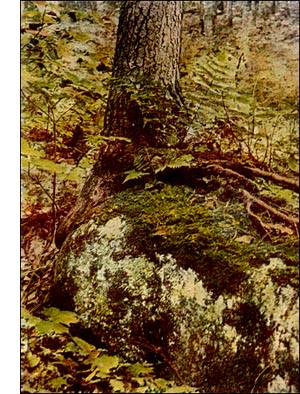Woolly Torn Veil Moss
 The Woolly Torn-veil Moss, Racomitrium lanuginosum, Brid.
The Woolly Torn-veil Moss, Racomitrium lanuginosum, Brid.Habit and habitat.-Common on the tops of walls and on rocks in mountainous regions. The thick grayish-white tufts extending in wide patches.
Name.-The specific name lanuginosum, woolly, was applied by Bridel to describe the white appearance due to the transparent tips of the leaves.
Plant (gametophyte).-Long and slender, stems 1 to 12 inches long, prostrate, branches in pairs, the side branches numerous.
Leaves.-Close, long-spreading, erect or recurved narrowly lance-shaped, bent to one side toward the apex; apex tapering to a white transparent hair-point often longer than the leaf-blade; vein narrow; margin from the middle upward a pellucid membrane bearing tiny protuberances, and bordered with hair-like teeth, wavy when dry; cells, those of the margin very small, dot-like; those of the leaf-blade narrow.
Habit of flowering.-Male and female flowers on separate plants (dioicous).
Veil. -Resembling a bishop's mitre, long-beaked, rough at the apex only.
Spore-cases.-Oblong, egg-shaped, palebrown, finally darker.
Pedicel.-Short, 1/5 to 1/2 of an inch long on a lateral branchlet.
Lid (operculum).-Tapering from a conical base.
Teeth (peristome).-Long, cleft into two forks; orange-red.
Annulus. -Broad. Spores.-Mature in summer.
Distribution. -Universal.